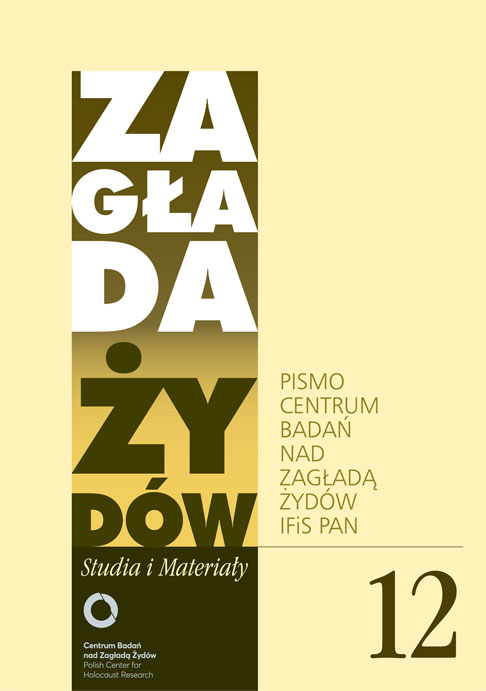Death of the Antiquarian on Chłodna Street
Zagłada Żydów. Studia i Materiały, No. 12 (2016), pages: 262-278
Publication date: 2016-11-30
Abstract
The great liquidation campaign in the Warsaw ghetto began on 22 July 1942. Throughout its course, more than 250,000 ghetto residents were deported to the death center in Treblinka. A day before, in order to inspire an atmosphere of terror and resignation, the Germans organized a liquidation of well-known representatives of the ghetto intelligentsia. The murder of a Jewish antiquarian in an apartment on Chłodna Street and Professor Franciszek Raszeja, a famous Polish doctor, called from the ‘Aryan’ side, echoed far and wide on both sides of the wall. In survivor testimonies and post-war memories as well as in studies produced on their basis it was assumed that the murdered antiquarian was Abe Gutnajer, the most famous pre-war Warsaw art dealer and the owner of the prestigious ‘Salon Sztuki’ antique art store on Mazowiecka Street. Aside from Gutnajer and Raszeja, the Germans purportedly murdered Abe’s entire family and people who accompanied Raszeja during the surgery. Nawojka Cieślińska- Lobkowicz, who had studied the history of the occupation-period art market for years, argues that the victim of that crime, committed probably in the morning of 22 July 1942, was not Abe Gutnajer but his elder brother Bernard, who before the war owned an antique store on Wierzbowa Street. He was killed along with Albert Schulberg, an antiquarian from Lvov, whose activity in the Warsaw ghetto consisted in, for instance, purchasing works of art and antiques for Zofia Leśniewska’s occupation-period antique art store, which he did with the Germans’ permission. Bernard Gutnajer was the one who called Professor Raszeja for a consultation to his apartment on Chłodna Street.
Keywords
Warsaw ghetto, liquidation campaign, 21 and 22 July 1942, Chłodna Street, Jewish art dealers, Abe Gutnajer, Bernard Gutnajer, Doctor Albert Schulberg, occupation period art market, Franciszek Raszeja
License
Copyright (c) 2016 Zagłada Żydów. Studia i Materiały

This work is licensed under a Creative Commons Attribution-NonCommercial-NoDerivatives 4.0 International License.
https://creativecommons.org/licenses/by-nc-nd/4.0
Other articles by the same auhtor(s)
- Nawojka Cieślińska-Lobkowicz, World War II Tragedy Memorial Museum , Zagłada Żydów. Studia i Materiały: No. 13 (2017)
- Nawojka Cieślińska-Lobkowicz, Munich Documentation Centre for the History of National Socialism and the German Collective Memory , Zagłada Żydów. Studia i Materiały: No. 12 (2016)
 English
English
 Polish
Polish



